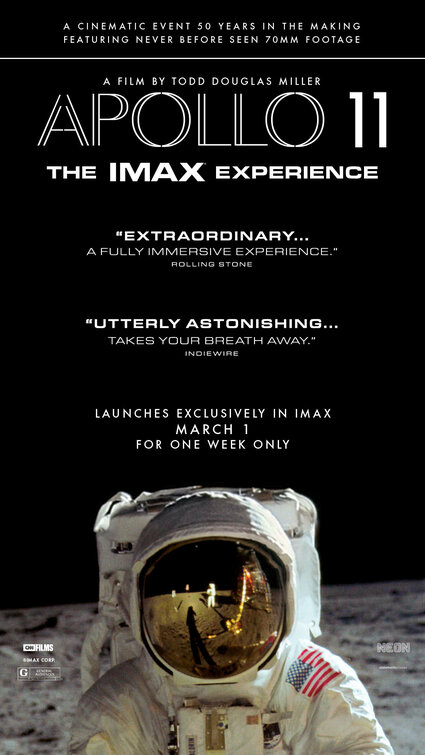Apollo 11 (2019)


SHOULD I SEE IT?
YES
Truly “found-footage”, Apollo 11 is an astonishing film, showing us 93 minutes of footage from the ground, the air, and the universe we have never seen before.
Meticulously and painstakingly made, with Oscar-worthy work in the areas of sound editing, film editing, and sound mixing.
The fact that this material existed in the National Archives and with NASA, but never saw the light of day, is unbelievable, especially when we see what was in the vault.
NO
I suppose those with no interest in outer space, space travel, or anything resembling that, will take a hard pass at this.
For some viewers who are not as knowledgeable about this moment in history, the film could do a better job at providing some basic, preliminary context for what’s happening. Maybe it assumes a little too much of its audience?
No narration, no talking heads. This is 93 minutes of raw footage assembled. The film is exceptional, but lacking the conventional framework of most documentaries, some may find this boring.
OUR REVIEW
The connection director Todd Douglas Miller makes with his audience in the new archival footage documentary, Apollo 11, rivals that of the emotions we feel in the fictional movies we love each and every year.
Serving as an instant companion piece to Damien Chazelle’s Oscar-winning First Man, Miller has compiled one of the most immersive and riveting documentaries of recent memory. Walking us through the preparations, launch, and eventual history-making landing on the moon, where astronauts Neil Armstrong and Edwin “Buzz” Aldrin walked on the lunar surface, and concluding with the return home, Miller transports us back to July 1969, on the eve of the 50th anniversary of the Apollo 11 mission.
Inspired by a documentary on a different Apollo mission, Miller and his production team worked with NASA and NARA (National Archives and Records Administration) to see what footage existed, in the hopes of putting together a 50th anniversary tribute to the launch. What they unearthed was a staggering amount of unreleased footage, shot on 70 mm no less, and internal audio recordings, which provided incredible insight, imagery, and context few, if any, had ever witnessed or heard.
Miller and his team went to work and eschewed the use of narrators or “talking heads,” letting the footage speak for itself. We join the film approximately three hours ahead of launch, and within minutes will see thousands of spectators line the beach and viewing areas on a hot July morning near Cape Canaveral, Florida, where Armstrong, Aldrin, and pilot Michael Collins will soon make history.
We hear internal conversations of NASA engineers and see dozens of technicians milling around and/or sitting at desks with pads of paper and notebooks in front of them. Miller allows the footage to tell the story, and, at least in the beginning, contextualizes the period with a few soundbites of news footage (Ted Kennedy’s Chappaquiddick scandal would break two days after Apollo 11 launched into space, for example).
Miller assembles his film meticulously. He finds astonishing footage from the elevator/platform as it travels the length of the rocket, the ground becoming more microscopic in size by the second. The scope of the launch is immense, and the buzzing of the spectators is palpable. Though there is no narration to walk us through the film (more on that in a moment), a stunning score from Matt Morton, composed on Moog synthesizers and other instruments from the time period, is a melodic, industrial punctuation to the journey we are embarking on. Morton’s score is dramatic, seldom subtle, but never overpowers the experience.

Watching this, you would swear Miller staged re-enactments, but nothing here is fake (including the Moon landing, you conspiracy wonks…). Enhanced with Morton’s compositions and a tremendous sound design from Eric Milano, Apollo 11 is one of the most technically proficient films of the decade. Miller and his team open up our eyes to a history that has never been shown quite this way.
Apollo 11 trusts its audience, which could leave some asking more questions than Miller is willing to answer. Efficiently paced, Miller offers no title cards with additional information, and provides no greater context for the history about to unfold. And while we want to believe that the Apollo 11 mission is an easy recall in the minds of all who are watching, NASA has not sent a manned spaceship to the Moon since Apollo 17 in 1972. Guiding the audience along would have helped, as would subtitling some of the more difficult to discern audio clips.
Be that as it may, Apollo 11 is frequently breathtaking, especially in those incredible moments when one small step for a man and one giant leap for mankind became the words and images forever associated with not only this moment in history, but America’s space program moving forward.
Miller’s collaboration with CNN Films, NASA, and NARA could become not only a bellwether for more “found-footage” compilation documentaries in general, but Apollo 11 could potentially restore a fascination with space travel. With the recent news that NASA will attempt a return to the Moon in 2023 and continued robotic-led explorations of Mars frequently making the news, we remain a culture curious and fascinated with the universe and all the mysteries it can offer.
Minute-by-minute, we are transported back to an experience defined by innocence and youthful curiosity. Apollo 11 allows us to feel that sense of wonder all over again.
CAST & CREW
Documentary Featuring: Neil Armstrong, Buzz Aldrin, Michael Collins
Director: Todd Douglas Miller
Release Date: March 1, 2019
NEON
